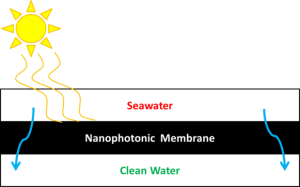Luna at Work to Purify Water Using Solar Energy
The availability of fresh water is recognized as a global issue of strategic relevance, with demand increasing due to factors like population growth and agricultural and industrial demands. Many conventional technologies such as reverse osmosis (RO) work well in established communities with infrastructure and wealth to fund their operation but are not cost-effective for poor or remote communities or when traditional infrastructure is down, as in the case of a natural disaster. Even with technologies like RO, there is also a pressing need for reducing the cost of larger-scale desalination.
Seawater desalination represents the most technologically reliable and sustainable way to produce drinkable water to supplement increasing demands on already overtaxed fresh water resources. The global desalination capacity is above 86.8 million m3/day[1] and is expected to reach about 180 million m3/day by 2024 and 280 million m3/day by 2030.[2] The market is dominated by reverse osmosis, which due to its high-pressure operation, (≥35 bars) requires that it utilize electricity and expensive high-pressure-rated pumps, tubing and membrane modules, being poorly suited in isolated impoverished environments.[3]
Membrane distillation (MD) is an emerging thermal, membrane-based separation process. The driving force is the vapor pressure difference across the hydrophobic macro-porous membrane, resulting in vapor flows from the feed to the permeate side, where it condenses. Because only vapor can permeate, non-volatile constituents like salt present in the influent water are almost 100% rejected. Furthermore, MD may be a promising alternative or at least a complement to RO, not being limited by osmotic phenomena and having the potential to produce desalted water at recovery factors higher than 85%. However, current MD technologies still suffer from high energy consumption and low water production rate due to low thermal efficiency caused, in part, by temperature polarization, heat loss through brine discharge, and feed temperature drop across the membrane module. One big hurdle to wide-spread commercialization of MD involves membrane fouling and degradation.

Luna is developing and demonstrating a third type of MD-based desalination processes – nanophotonics enhanced direct solar membrane distillation (Figure 1). Our novel, green, solar powered water desalination process demonstrates high capability for seawater desalination with low energy consumption, driven entirely by the solar energy.
Luna’s nanophotonic technology is a unique approach to help resolve the current MD challenges. Luna combines varied nanosystems with commercially available, low-cost polymers to create a nanoenhanced MD membrane on an existing, commercially available MD membrane substrate. This can then be housed in a very simple, low-cost plastic module to generate pure water from feed sources like seawater, brackish water, sewage/industrial run-offs and contaminated or otherwise undrinkable water. In this compact design, the high effeciency solor-thermal convesion material is integrated into the MD module for elimnation of the temperature polarization. Flat sheet membranes coated with our proprietery nanosystems are placed in a module with a transparent window and the hot water flux directly generated at the localized membrane surface under the solar irradiation. Unlike in traditional MD, where the driving force of vapor production (temperature difference) diminishes over the module length thereby leading to significantly lower water production in long and densely-packed MD modules, Luna’s process successfully overcomes this drawback. At laboratory demostration, our nanophotnic desalination process was able to achieve <175 ppm TDS (total dissolved solids) fresh water output at zero external energy consumption, which is <35% of the maximum TDS limit for drinking water of 500 ppm.[1]
Luna’s nanophotonic desalination technology uses inexpensive membranes already optimized for MD process. The membrane housing is also inexpensive due to its low-pressure requirements, as opposed to RO’s. The housing is chemically stable and inert, thermally stable and durable, and adaptable to a variety of environments/conditions. Our all-in-one solar MD system does not need to have separate hot tanks, solar cells, membrane housings, or pumps in most cases.
The same enabling technology can also be used to make water of greater purity than even drinking water, such as for various medical applications. This is due to a combination of factors including almost complete rejection of non-volatile components and sterilization of the permeate vapor since the nanophotonic layer can create localized steam at above 121 °C.
Luna’s evolving nanophotonics enabling technology continues to be optimized to improve the performance and cost-effectiveness of this novel zero-energy water distillation process targeted to cost-effectively enhancing global RO systems and enabling broad utilization of small-scale distributed water production, meet the needs of remote/isolated communities in the military and civilian sectors, and help eliminate the lack of clean, drinking water suffered by many around the world.
1 http://idadesal.org/desalination-101/desalination-by-the-numbers/. Accessed 3/31/2017.
2 http://www.nextbigfuture.com/2013/10/desalination-water-world.html. Accessed 3/31/2017.
3 “Analysis of Global Desalination Market,” Frost & Sullivan, September 2015
4 Kalogirou, S. A. Seawater desalination using renewable energy sources. Progress in Energy and Combustion Science 2005, 31 (2005), 242–281.